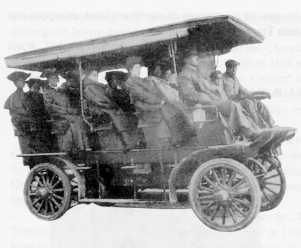The Union Transportation Company was organized to provide "a convenient transportation for Negro messengers, merchandise, traffic and freight throughout the cities and towns of Tennessee and the United States." Although the charter was worded to allow for the operation of streetcar facilities in other parts of Tennessee, Nashville was its immediate goal. News of the new business venture and the appearance of a temporary system of horses and wagons for transporting black passengers around the city gave new life to the two-month-old boycott. The white street railway operators endured economic hardship in the face of determination exhibited by black Nashvillians. For example, the Nashville Transit Company reportedly lost $500 per week by mid-September.
The purchasing agent for the Union Transportation Company, Richard H. Boyd, bought five large (fifteen passenger) steam-propelled automobiles and took an option to buy twenty more vehicles. The company employed ten men, and the officers donated their time. The autobuses arrived in Nashville on September 29, and the dedication ceremonies were held in Watkins Park on October 2, 1905. The regular lines of travel were started on Tuesday, October 3. Four of the five cars were in constant service and a fifth car was held in reserve.
 The Union Transportation
Company soon experienced problems. The steam-propelled buses lacked adequate
power to traverse the steep grades of Nashville's terrain and keep regular
schedules. To correct the problem, the company's officers traded the machines
for fourteen electric automobiles that carried twenty passengers each.
Emboldened by the support of the Nashville Globe, the company put
its electric cars into operation in January of 1906. After having its batteries
ruined by overcharging at the Nashville Railway and Light Company's facilities,
the Union Transportation Company installed its own dynamo and electric-generating
equipment at the Nashville Baptist Publishing Board's facilities. This
proved to be a futile effort, because the batteries could not be adequately
charged by the new generator.
The Union Transportation
Company soon experienced problems. The steam-propelled buses lacked adequate
power to traverse the steep grades of Nashville's terrain and keep regular
schedules. To correct the problem, the company's officers traded the machines
for fourteen electric automobiles that carried twenty passengers each.
Emboldened by the support of the Nashville Globe, the company put
its electric cars into operation in January of 1906. After having its batteries
ruined by overcharging at the Nashville Railway and Light Company's facilities,
the Union Transportation Company installed its own dynamo and electric-generating
equipment at the Nashville Baptist Publishing Board's facilities. This
proved to be a futile effort, because the batteries could not be adequately
charged by the new generator.
The demise of Union Transportation was waiting in the wings. The impetus required to maintain the enormous financial undertaking had ceased, and payment on the subscribed stock slowed. In addition, in April of 1906 the City of Nashville indicated its plan to levy an annual privilege tax of $42 per car. These taxes and persistent battery trouble caused the company to cease operations by mid-summer. In 1907, Boyd sold the company's cars to the Jamestown Exposition in Virginia.
Black Nashvillians were brought to the gateway of significant black enterprise and victory over Jim Crow by the Union Transportation Company.